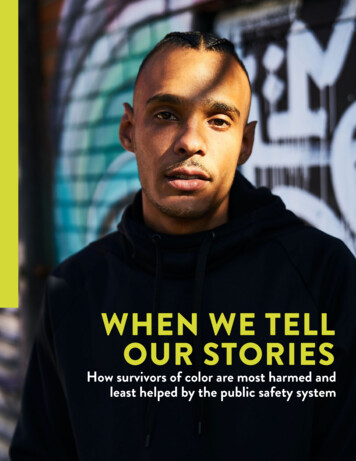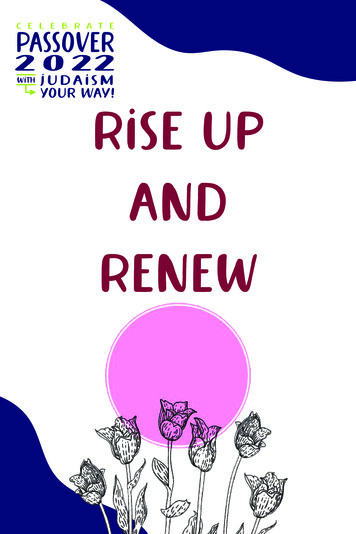
Transcription
WHEN WE TELLOUR STORIESHow survivors of color are most harmed andleast helped by the public safety system
2Steering CommitteeMembersBeezie Burton, Project Intern, Conflict Resolution Master of Arts Program, Portland State UniversityCyn Connais, PsyD, Clinical Psychologist, Healing Hurt People, Cascadia Behavioral HealthcareAmy Davidson, Crime Survivor Program Director, Partnership for Safety & JusticeAntoinette Edwards, Director (retired), Office of Youth Violence Prevention, City of Portland, OregonYolanda Gonzalez, Program Manager, Community Healing Initiative Program, Latino NetworkTrish Jordan, Executive Director, Red Lodge Transition ServicesRashida Saunders, Crisis Response Team Coordinator, Police Bureau, City of Portland, OregonChanel Thomas, Victim Advocate, Victim’s Assistance Program, Multnomah County District AttorneyA Note from theSteering CommitteeOur first commitment to this process was to have it be guided by people from the communities whosestories it aspires to tell.Engaged with survivors of color from the communities in which we live, we are community advocates whowork within law enforcement, city- and county-level agencies, community-based reentry programs, andbehavioral healthcare systems.We collaborated on this project in which Partnership for Safety & Justice played a coordinating role. Asdirectors of the project, we developed the questions and invited participants. We conducted the individualand group interviews, and we provided guidance to staff and interns on interpreting and contextualizingresponses. And we also played a core role in determining the final recommendations that grew out of thedozens of interviews that were conducted.
3AcknowledgementsWe’re deeply grateful to all those who were involved in and supported this project. Special thanks toour interns: Bianca Pak, Sophie Adler, Stephanie Grayce, and Roberta Munger whose compassion anddedication to equity and healing pave the way for change.We’re grateful to Anna Rockhill, M.A., M.P.P, Senior Research Associate, Portland State University,whose expertise helped guide this report. You were an indispensable gift to the process.An extended thank you also to Roy Moore III, Trish Jordan, and Antoinette Edwards who became adynamic trio of prophetic messengers, sometimes quiet, sometimes loud, always real, always guided bylove. Thank you to Alejandra Galindo who provided Spanish translation and moreover ensured that thevoices of Latinx survivors remain a strong and necessary voice in policy change.To two of our Steering Committee partners who went above and beyond: Beezie Burton, who was ourprimary project intern while also completing her Masters Degree thesis on this project. You are magic,sister. This couldn’t have happened without you.And deep gratitude to Yolanda Gonzalez. You were a compass from the start. You saw us through everystage of this process, keeping us honest, and shining the light you always shine toward a better way. Youheld space for almost every individual who touched this. In tears and in laughter, thanks for all the heartand integrity and always believing in the power of this.To all our friends and colleagues who got messages at unreasonable hours pleading for your expertise: Youare all essential parts of a much larger movement that will lift up these stories and bring healing. Thank youfor what you bring to the world.And most importantly, to the survivors who participated in these conversations: Thank you for your stories.We’re endlessly inspired by your hearts, your resilience, and your courage. Universally, you voiced a desireto make things better for others by sharing your story. We’re so honored to have shared this experiencewith you.Juntos avanzamos.
4Project TeamCOMMUNITY HEALING INITIATIVEPROGRAM, LATINO NETWORKlatnet.org/chi-overviewLatino Network, in partnership with the Multnomah County Department of Juvenile Justice, runs theCommunity Healing Initiative (CHI) and Early Intervention Community Healing Initiative (Early CHI) toprevent and reduce youth violence, decrease rates of juvenile justice involvement, and increase communitysafety. CHI engages our highest risk, adjudicated Latino youth on probation and parole to set and pursuepositive life goals and to avoid future incarceration.CRISIS RESPONSE TEAM, POLICE BUREAUCITY OF PORTLAND, OREGONportlandoregon.gov/police/72124The Mission of the Portland Police Bureau’s Crisis Response Team is to intervene in traumatic situationswhich impact individuals, families, and the community at large. The Crisis Response Team responds toincidents in an effort to enhance community livability and reduce the threat of violence and the fear of crime.This is achieved through crisis counseling, emotional and bereavement support, and improved communicationamong all groups who are affected by such incidents.* While Police Bureau staff advised and was involved in many aspects of this project and research, the Bureau didnot ultimately take a formal position in endorsing this report.Healing Hurt People, POICportlandoic.org/resourcesThe HHP program serves individuals of color, ages 10 to 35 years, who have experienced intentional traumasuch as gunshot or stab wounds. HHP Portland employs a trauma-informed approach, which takes intoaccount the adversity clients have experienced over their lives, and recognizes that addressing this traumais critical to breaking the cycle of violence. The program was originally launched in 2013 through CascadiaBehavioral Healthcare, and it transitioned to POIC as a service partner with Legacy Emanuel Hospital in2018.
5OFFICE OF YOUTH VIOLENCE PREVENTIONCITY OF PORTLAND, OREGONportlandonline.com/safeyouthThe Office of Youth Violence Prevention (OYVP) was created in 2006. It reflects priorities identified by CityCouncil to build a more family-friendly city and increase public safety, and reflects the emphasis on attackingthe root causes of problems in neighborhoods, rather than simply focusing on policing efforts. OYVP isstaffed by a director and policy manager who coordinate resource services, administer grant funding to privatenon-profit organizations, and facilitate and join community problem-solving.PARTNERSHIP FOR SAFETY & JUSTICEsafetyandjustice.orgPartnership for Safety & Justice is Oregon’s leading public safety and criminal justice reform organization.Our mission is to transform society’s response to crime through innovative solutions that ensureaccountability, equity, and healing. We advance reforms that promote social and racial equity; reduce levels ofincarceration and criminalization; and better address the needs of crime survivors, people convicted of crime,and the families of both.RED LODGE TRANSITION SERVICESredlodgetransition.orgRed Lodge Transition Services is a non-profit grassroots organization supported by volunteers who haveexperience working with men and women in prison. Our primary objective is to assist Native men and womenwho are ready to transition from prison, jail, and treatment back to community. Creating a realistic plan fortransition can be very stressful! There are many obstacles and barriers each person, family and communitymust navigate through in order to be successful. Red Lodge Transition Services is working to identify barriersand help prepare people for successful re-entry.VICTIM’S ASSISTANCE PROGRAMMULTNOMAH COUNTY DISTRICT ies/victim-The primary goal of the Victim’s Assistance Program is to make the criminal justice system more responsiveto individual citizens, particularly to victims of crime. A primary concern of the District Attorney’s Office isto ensure crime victims a meaningful role in the criminal and juvenile justice system and to accord them duedignity and respect. To this end it is the philosophy of the office that every effort be made to maximize victiminvolvement at every possible stage of a criminal case. The office is committed to full implementation ofVictims Rights as embodied in Oregon law.
6WHEN WE TELL OUR STORIES — SUMMARYExecutive SummaryMost crime survivors want a public safety system that offers a pathway to accountability for harm, support for healing,and a process of restoration after experiencing violence.While decades of research have informed programs and services that best meet crime survivors’ needs, remarkablylittle attention has been paid to the experiences of survivors of color.This report delves into one overarching question: What do survivors of color need in the aftermath of trauma?The qualitative research collected here presents the lived experiences of 40 Black, Indigenous, Latinx, and multiracialsurvivors. While participants’ experiences are as diverse as the people themselves, their voices converged over sharedthemes of invisibility, strength, distress, resilience, unhealed trauma, and determination.The data pointed to four findings.Finding #1: Mostsurvivors of color do notreport crimes.The vast majority of survivors interviewed in ourstudy did not report the crime or crimes they experienced, mostly out of fear that they’d be disbelieved,blamed, ignored, or harmed further by police. Andwhile generations of survivors of color have turnedwithin their close-in networks for safety and healing,broader community-based support is limited.Consequently, crime survivors of color are less likelyto experience healing and resolution that could comewith survivor programs and services. to experienceFinding #2: Most survivorsof color do not have accessto opportunities to heal.healing and resolution that could come with survivorFew survivors of color felt supported by the public safetyprograms and services.system in the aftermath of a violent incident.
7WHEN WE TELL OUR STORIES — SUMMARYMost received no information on how to navigate theThis range of factors and traumas notwithstanding, crimecriminal justice system or how to access traumasurvivors of color expressed what was missingsupport; when help was offered to survivors, it wasfrom our current public safety approach and how weoften culturally inaccessible.can improve services to achieve better outcomes.Finding #3: The criminaljustice system prioritizesprosecution andincarceration over theneeds of survivors.Survivors of color expressed that their needs weregenerally not met by the criminal justice system.Survivors wanted accountability, justice, and safety,but many felt that the criminal justice system’s meansof achieving these were inadequate, narrow, andThis range of factors and traumas notwithstanding, crimesurvivors of color expressed what was missing from ourcurrent public safety approach and how we can improveservices to achieve better outcomes.Recommendation #1:Elevate restorative practicesthat are responsive to anddriven by people impactedby harm.sometimes even at odds with what they would haveCity, county, and state governments and fundingliked. With the system’s strictly punitive focus onorganizations need to invest in community-drivenprosecution and incarceration, it offers no options forrestorative processes. Survivors should have the option ofpeople to get on the path they need to heal.choosing a restorative process, not just be given the falseFinding #4: Manysurvivors of color do notidentify as victims.Survivors of color, particularly men, found it difficultto acknowledge that they have been a victim and needhelp to heal. Survivors attributed this to a range offactors: racial bias in the criminal justice system thatassumes men of color are potential perpetrators; thefalse binary that a person can either have committeda crime or been a victim, but not both; and a cultureof masculinity that socializes men to think that beinga victim or needing help is a sign of weakness.choice of incarceration or not accounting for harm at all.
8WHEN WE TELL OUR STORIES — SUMMARYRecommendation #2:Substantially increasefunding for new andexisting community-basedand culturally specifichealing services.Criminal justice systems should shrink the use ofprosecution and meaningfully invest in communitybased and culturally specific services for peoplewho have experienced harm and violence. Theseservices should be readily available and not dependon a survivor’s willingness to prosecute the harm orotherwise cooperate with law enforcement.Recommendation #3:Identify and addresshistorical trauma to Black,Indigenous, and Latinxpeople and communitiesas well as other people andcommunities of color inOregon.The state needs to conduct its own truth andreconciliation process to identify and address theharms of historical trauma to people and communitiesof color in Oregon. The process must be driven andinformed by Black, Indigenous, and Latinx people, aswell as other people of color.Recommendation #4:Improve public safety andother agencies’ capacityto serve people who haveexperienced trauma andsurvived violence.The state should require training in culturally specific andhealing centered approaches for law enforcement andother relevant agency staff who interact with people whohave experienced trauma or been harmed by violence,with measured in changed outcomes for survivors.
WHEN WE TELL OUR STORIES — SUMMARY9Part Three of this report outlines different actions thatall of us can take to advance the changes we need.Whether as a community member, advocate, direct service provider, public safety professional, or elected official,we all have an important role in creating and supporting better outcomes for Black, Indigenous, Latinx, and othersurvivors of color in our communities.Together we can use theresources and power we haveto meaningfully transformour response to violence— one rooted in humanity,equity, accountability, andhealing.Copyright December 2020 by Partnership for Safety & Justicesafetyandjustice.org and tyandjustice.org 503-335-8449
TABLE OF CONTENTSIntroduction12Part 1. Findings: How we fail to meet the needs of survivor ofcolor16#1. Most survivors of color do not r eport crimes17#2. Most survivors of color do not h ave access toopportunities to heal27#3. The criminal justice system prioritizes prosecution andincarceration over the needs of survivors33#4. Many survivors of color do not i dentify as victims38Part 2. Recommendations for better outcomes f or survivors ofcolor40#1. Identify and address historical trauma to Black, Indigenous,and Latinx people as well as other communities of color42#2. Substantially increase funding for new and existingcommunity-based and culturally specific healing services.46#3. Elevate restorative practices that are responsive to anddriven by people impacted by harm.50#4. Provide trauma education to public safety and otherresponders (such as hospitals and schools), and evaluatetheir engagement with survivors of violence.54Part 3. What you can do to create and support better publicsafety outcomes58Appendix62Endnotes66
12IntroductionDecades into research, advocacy, and coordinated support for crime survivors, remarkably little attention hasbeen paid to the experiences of survivors of color. As hasThe year 2020 has brought unfathomable changesto our lives and communities, which were not initiallyaccounted for in the creation of this report. Froma global pandemic to the police murders of GeorgeFloyd, Breonna Taylor, Ahmaud Arbery, and far toomany others, we have been called to reckon withthe systemic racism and visceral inequality so deeplyrooted in our country. But in the face of this starkreality, there is also a truth that shines so abundantlyclear — that transformative change is possible. In anarrow window of time, we are already seeing thesechanges take form. New language is emerging, newleaders are developing alongside leaders who havebeen organizing for generations, and a new world istaking shape. It’s these monumental shifts that shakeus by the shoulders with a powerful reminder — thatrelationship, essential and inescapable, lives andbreathes new life into all aspects of healing.The power of relationship is woven into every aspectof this work. And while we anticipated releasing thisreport a year earlier, we are clear that it has nevercome into sharper clarity during the Black Lives Mattermovement, Black, Indigenous, and Latinx communitieshave not been historically centered in public safety systems’ commitment to protection and service.In the existing body of research on survivors, there is verylittle that disaggregates data on race and even less thatdelves into specific communities of color. With the hopeof shifting focus toward the experiences of the peopleand communities most harmed and least helped by ourcriminal justice system, one question set this report intomotion: What do survivors of color need after experiencing violence?Partnership for Safety & Justice (PSJ) is a small nonprofitpolicy and advocacy organization that couldn’t answer thisquestion alone. What PSJ could do, however, is organizea team of incredible partners, build community, dive intothe deep end, and find solutions.As a committee with members from diverse organizations,we brought deep relationships and experiences to engag-been more relevant or necessary than now.ing survivors of color in conversion about their experienc-As we reflect on this historical moment, we releaseAmerican women at the Coffee Creek Correctionalthis report in honor of the Black, Indigenous, andPeople of Color whose lives have been lost to systemicracism and violence. May the light of their truth andsong of their story carry us to what is possible.es. Through Red Lodge Transitions, we interviewed NativeFacility; Latino Network engaged Latina women survivors;with the City of Portland’s Office of Violence Prevention,we talked with African American women survivors; andtogether we identified men of color who have survivedviolence and are now working to create solutions.
13INTRODUCTIONBetween 2017 and 2018, we interviewed 40 Black,need to heal and thrive.Indigenous, and Latinx survivors who have experiencedserious crime or violence. The crimes includedWe also heard stories of incredible compassion andburglary, assault, attempted murder, sexual violence,healing and inspiring visions of what communities need tomurder of a family member or more than one of theseheal and thrive.experiences. Participants ranged in age from 25 to 73years old; 17 identified as male and 23 identified asThis report is not a comprehensive representation of allfemale. No participants identified as transgender orcrime survivors of color; perspectives of survivors arenonbinary. All of the participants were residing in theas broad and diverse as the number of people harmedgreater Portland metropolitan region in Multnomah,by crime. Rather, it presents a snapshot of the livedWashington, and Clackamas Counties; however,experiences of 40 Black, Native, Latinx, and multiracialsome of the stories that were shared referred tosurvivors who were willing to share their stories. Theirevents that happened outside of this region.voices and experiences converged over shared themes ofinvisibility, strength, distress, resilience, unhealed trauma,We used written questionnaires, individual interviews,and determination.and focus group sessions to gather qualitative data ona core set of questions:- What do survivors of color need in theaftermath of trauma?The voices in this report need to be heard now more thanever, and yet this study is only a starting point that barelyscratches the surface. It reimagines a public safety system- What supports and/or prevents survivors ofthat heals rather than deepens the trauma of survivorscolor from accessing the public safety andwith a vision for change and a call to action that’s alsocriminal justice systems?being put forth by community leaders who are emerging- How does the criminal justice system interactfrom this moment.with communities of color, and what are theimpacts of those contacts?Because by meeting the needs of survivors of color, wecan build a system that ensures healing for all of Oregon’sThrough these monthslong conversations, participantsshared profound stories of pain and power, loss andgrowth, despair and healing. We talked with motherswho lost their children to violence; fathers who wereconditioned to accept trauma as a common fact oflife, much like their fathers; and people who hadsurvived physical abuse at the hands of loved ones, lawenforcement, or a nameless stranger who has neverbeen held accountable.We also heard stories of incredible compassion andhealing and inspiring visions of what communitiescommunities.
14A Values-BasedApproachThe development, delivery, and determinations of this study were guided by our commitment to a numberof fundamental values: that our work be culturally specific; centered in healing; relational; and accessible,flexible, and adaptable.Culturally specific. Focus groups and interviews were conducted in languages fluent to participants,delivered by facilitators from their community, and held within their community.Centered in healing. A culturally specific licensed mental health provider or direct service provider wasavailable to all participants before, during, and directly after each interview and focus group. Participantsmaintained control of their anonymity, their story, and whether their experiences would be shared.Relational. Participants were identified by Advisory Committee members who were familiar with thecommunity and who had knowledge of who might personally value participating in the study. Trust wasbuilt through multiple interactions prior to participation, through transparency and honoring the wholeperson.Accessible, flexible, and adaptable. Project staff introduced community members to the goals andintentions of the study, giving potential participants an opportunity to fully understand the process andhave all their questions answered.Focus groups and interviews were held in locations that were chosen as places that would be familiarand accessible to participants. Culturally specific child care was available, and participants receivedcompensation for their travel and time. Survivors participated in either a focus group or a one-on-oneinterview, depending on their unique circumstances. Facilitators sometimes rephrased questions so thateveryone in the room could understand and contribute to the discussion.For participants who were incarcerated, the process was adapted to ensure its integrity while also adheringto facility regulations and preserving participants’ privacy, confidentiality, and protection.
15A note on the use ofsurvivor versus victimVictim is the word mostpredominantly used within ourcriminal justice system, but serviceproviders who work with peoplewho’ve experienced violence havelargely abandoned it. Victimpositions people as essentially stuckin an event or events that hurtthem, and it falsely suggests thatthe experience of being harmed isunchangeable.But people who have experiencedharm recognize that harm andhealing happen on a continuum,and the word survivor betterdescribes the complex experiencesalong that process. For thesereasons, and to honor the wishes ofthose who shared their stories, weuse the word survivor.
PART 1.FINDINGS
17How we fail to meetthe needs ofsurvivors of colorThe public safety system is intended, in part, to offer crime survivors a pathway to accountability for harm, supportfor healing, and a process of restoration after surviving crime and violence. However, the current system’s responseto harm invests heavily in policing and incarceration. This approach has resulted in deep and profound racialdisparities in the public safety and criminal justice systems and fails to adequately provide support services for crimesurvivors.Crime survivors’ experiences are as diverse as the people themselves. The survivors of color who participated in ourstudy described situations that were complex and filled with nuanced feelings about law enforcement, the criminaljustice process, and the public safety system as a whole. Reporting crimes to law enforcement and seeminglyinsurmountable barriers to healing were the two topics that generated the most discussion and exposed a collectivesense of despair, disbelief, and distrust.This section highlights and explores the barriers to reporting harm, the consequences to survivors and families of notreporting, and the roadblocks to healing.FINDING #1Most survivors of color donot report crimes.In the immediate aftermath of crime or violence, theresponse to the harm they’ve experienced. A survivormost urgent need generally centers around personalmight report a violent incident to seek protection, tosafety. This can include finding a safer place to stay,access services, to seek justice, to receive compensation,receiving physical or mental health care, or reachingto ensure that others won’t be harmed, or to find a senseout to trustworthy people to talk to for a sense ofof healing.grounding. For some people, it’s important to reportthe crime to law enforcement and engage a formal
PART 1 — FINDINGS18Yet many survivors of crime don’t report to lawenforcement. In fact, the majority of crimes are neverreported to police. In 2017, the United States Bureauof Justice Statistics (BJS) found that 57% of violentcrimes tracked by BJS were not reported to police.1Racial bias and othernegative past experienceswith law enforcement andthe criminal justice systemOur interviews with survivors of color painted an evenstarker picture.Among the 40crime survivorsinterviewedin our study,75% said theydid not reportthe crime.This gap prompted us to ask why. What are thebarriers that prevent survivors of color in Oregonfrom reporting? Are there dynamics that need tobe better understood so that we can begin to bridgethe gaps in serving survivors or color? What are theimpacts of not reporting?While the reasons for not reporting to the publicsafety system are complex and varied, twopredominant and distinct barriers emerged in ourinterviews: (1) racial bias and other negative pastexperiences with law enforcement and in the criminaljustice system and (2) fear of family separation.After surviving trauma, people often feel overwhelminglyvulnerable, and the majority of survivors we spoke withsaid that the public safety system often deepened thissense of powerlessness.Survivors pointed to having personally experiencedinteractions with law enforcement that were rife witheverything from ambivalence to hostility to racism andeven violence. Set against a backdrop of personal trauma,as well as trauma experienced by generations of familymembers before them, these negative past experiencesmade our respondents doubtful that the police would be asource of safety.A handful of stories did reflect positive and neutral experiences about police and criminal justice system responses. For the majority of survivors, however, the focus wason the risks, vulnerability, and harm that Black and brownsurvivors experience when calling the police after a violent“incident.It’s like they don’t see us. Theydon’t believe you or give us help.You don’t feel protected. Youfeel really horrible. You don’treally feel like you can moveahead, because you don’t evenhave the support of the police.
PART 1 — FINDINGS19Feelings of invisibility and neglect were widespreadin our interviews, which parallel national trends. In arecent national survey about trust in law enforcement,only 36% of Black Americans say they trust theirlocal police very much compared to 77% of whiteAmericans.2Survivors also had a lot of mistrust of individualpolice officers as well as of the broader criminaljustice system, including prosecutors, courts, andcorrections. Among crime survivors of color in ourstudy who did seek help and support from the publicsafety system, many spoke about how the justicesystem did not come through on their promises of asafer community.“My only fear of callingthe police is, Are youguys going to respondfast enough? Becauselet’s keep it real: We allknow there are certainparts of town you cancall the police 100 times,and they might notnever show up. Call fromanother side of town, andthey got half the damnsquad there. So, it kind ofmakes me leery of callingthem.”There were several similar stories of people feelingbetrayed by a system that never found the responsibleperson, never delivered on justice, or never appeared tocare about the healing and recovery that the survivorssought and so desperately needed.“It’s coming up on three yearsfor me. I haven’t got no justice. Ihaven’t got nothing. About a yearafter my son was killed, I got a callfrom the police department totell me that the detective who wasworking on my case was retiring,and pretty much said that I’m onmy own. This will be my third yearwith no answers, and I still don’thave a son.”
PART 1 — FINDINGS20Worse still, a number of crime survivors talked aboutNone of this is news to Black and brown communities.experiencing violence at the hands of police. ManyWhen such incidents occur repeatedly to one’s friends,survivors of color pointed to police abuses that havefamily, and community for generations, mistrust foments.reinforced the belief that, not only are police officersThis is particularly true when the harm is caused bynot to be trusted to help, but law enforcement mightpeople who are supposed to be supporting and protectingcause more harm.communities.“We been beat up several timesby the police. So, the wholereporting thing is a no-no. Wejust kinda report to ourselves.”Police misconduct, brutality, and violence areThis experience mirrors national data. According to athreatening to and neglectful of communities of color lawrecent survey, 63% of African Americans and 51% ofLatinx people responded that they were worried thatthey or a family member will be a victim of deadlypolice force, while only 21% of white people sharedthat fear.3“THE REAL FEAR OF WHEN YOU HEARSIRENS IS KNOWING WHERE MY KIDS AREAT, BECAU
The criminal justice system prioritizes prosecution and incarceration over the needs of survivors #4. Many survivors of color do not identify as victims Part 2. Recommendations for better outcomes for survivors of color #1. Identify and address historical trauma to Black, Indigenous, and Latinx people as well as other communities of color #2.











